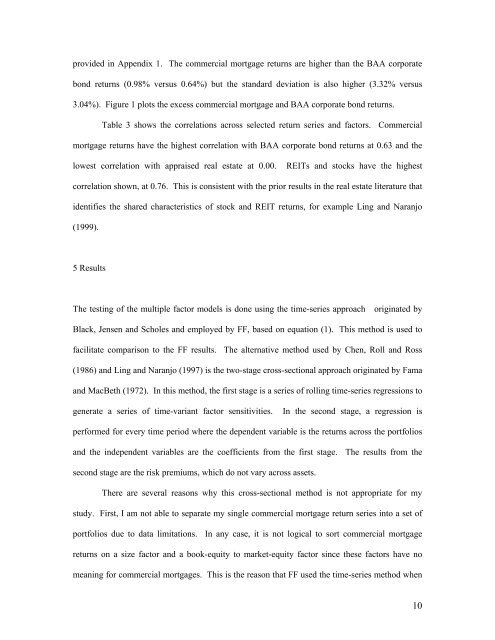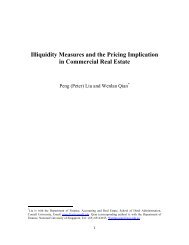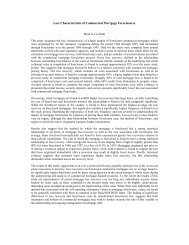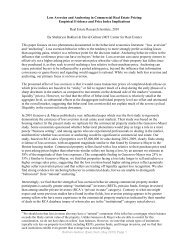Commercial Mortgage Delinquency, Foreclosure and Reinstatement
Commercial Mortgage Delinquency, Foreclosure and Reinstatement
Commercial Mortgage Delinquency, Foreclosure and Reinstatement
Create successful ePaper yourself
Turn your PDF publications into a flip-book with our unique Google optimized e-Paper software.
provided in Appendix 1. The commercial mortgage returns are higher than the BAA corporatebond returns (0.98% versus 0.64%) but the st<strong>and</strong>ard deviation is also higher (3.32% versus3.04%). Figure 1 plots the excess commercial mortgage <strong>and</strong> BAA corporate bond returns.Table 3 shows the correlations across selected return series <strong>and</strong> factors. <strong>Commercial</strong>mortgage returns have the highest correlation with BAA corporate bond returns at 0.63 <strong>and</strong> thelowest correlation with appraised real estate at 0.00. REITs <strong>and</strong> stocks have the highestcorrelation shown, at 0.76. This is consistent with the prior results in the real estate literature thatidentifies the shared characteristics of stock <strong>and</strong> REIT returns, for example Ling <strong>and</strong> Naranjo(1999).5 ResultsThe testing of the multiple factor models is done using the time-series approach originated byBlack, Jensen <strong>and</strong> Scholes <strong>and</strong> employed by FF, based on equation (1). This method is used tofacilitate comparison to the FF results. The alternative method used by Chen, Roll <strong>and</strong> Ross(1986) <strong>and</strong> Ling <strong>and</strong> Naranjo (1997) is the two-stage cross-sectional approach originated by Fama<strong>and</strong> MacBeth (1972). In this method, the first stage is a series of rolling time-series regressions togenerate a series of time-variant factor sensitivities. In the second stage, a regression isperformed for every time period where the dependent variable is the returns across the portfolios<strong>and</strong> the independent variables are the coefficients from the first stage. The results from thesecond stage are the risk premiums, which do not vary across assets.There are several reasons why this cross-sectional method is not appropriate for mystudy. First, I am not able to separate my single commercial mortgage return series into a set ofportfolios due to data limitations. In any case, it is not logical to sort commercial mortgagereturns on a size factor <strong>and</strong> a book-equity to market-equity factor since these factors have nomeaning for commercial mortgages. This is the reason that FF used the time-series method when10





